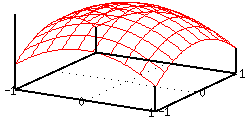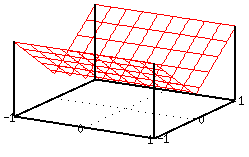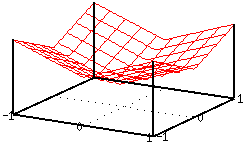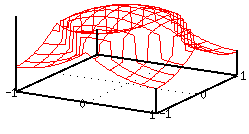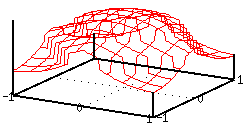 |
Spot function reference
Definition
Spot functions define the order in which pixels should be whitened as
a cell lightened in colour. They are defined over the entire cell,
and are called for each device pixel in the cell. The cell
co-ordinate space ranges from -1.0 .. +1.0 inclusive, in both x- and
y-axes.
This means the spot function f(x, y) must be defined
for:
- -1 <= x <= +1, where x is a real number, and
- -1 <= y <= +1, where y is a real number.
The function f's range is -1.0 ... +1.0 inclusive, but it is
permissible for f to return values outside this range: the nearest
valid value will be used instead. NOTE: this is in contrast with
PostScript spot functions, where it is a RangeError for the
spot function to go outside these limits.
An initially black cell is filled from lowest spot function value to
highest. The actual values returned do not matter - it is their
relative orderings that count. This means that spot functions do not
need to be tonally balanced. A tonally balanced spot function
is one which for all slices though the function (eg say at z),
the area of the slice = 4z. In particular, almost all
PostScript spot functions are not tonally balanced.
Ink behaviour
There are 3 other factors which affect how the spots ultimately
perform when printed. They are:
- dot gain
- tone jump
- plugging
In a printing press when ink is transfered to the paper, the dots tend
to grow slightly as the ink is absorbed by the paper. This effect,
termed dot gain, depends both on the type of paper being
printed on as well as the sort of ink in use. To complicate matters,
the dot gain is not constant for all dot sizes - in fact it is
proportional to the length of the dot's perimeter. As the dots change
shape, their perimeter length changes in a non-linear manner, and so
does the dot gain. Furthermore, dots smaller than a certain size may
not appear on the page at all.
As the spots get larger, at some stage neigbouring spots will touch.
When this happens, extra unwanted ink is deposited around the join.
This leads to a tone jump, as a smooth gradient will suddenly
jump in darkness when the spots begin touching.
When the spots become very large, they leave small gaps of unprinted
paper. These are liable to fill with ink, an effect known as
plugging. This results in loss of detail in the darkest areas.
Reducing the tonal range of the image prior to screening can mitigate
some of these problems, but selecting a dot function tailored to the
particular image can also improve matters. This is covered in the
following section.
Spot function characteristics
This section shows how a linear gradient between black and white
appears screened under a variety of different spot functions, all with
a cell size of 16x16. For each spot function, the screened gradient
is shown along with a surface plot of the spot function, and
closeups of the spot at 3 intensities. The blue frames show where the
cell boundaries are. The percentage intensities are quoted with white
at 100% intensity - this is a little unusual, since normally 100%
intensity means 100% ink, ie completely black.

Round
 1 - (x^2 + y^2)
The round spot function is one of the simplest functions. Because it
stays circular at all tonal intensities, it has the minimum possible
perimeter length, thus reducing dot gain as far as possible. The
tonal jump (where the spots first touch) happens well into the shadows
at around 22%, making this function good for images with smooth
transitions from highlights to midtones. Unfortunately the small
concave diamond shaped white holes have a rather large perimeter, and
are liable to plugging.
1 - (x^2 + y^2)
The round spot function is one of the simplest functions. Because it
stays circular at all tonal intensities, it has the minimum possible
perimeter length, thus reducing dot gain as far as possible. The
tonal jump (where the spots first touch) happens well into the shadows
at around 22%, making this function good for images with smooth
transitions from highlights to midtones. Unfortunately the small
concave diamond shaped white holes have a rather large perimeter, and
are liable to plugging.
Line
 abs(y)
The line spot function is normally only used for special effects,
usually at non-standard screen angles - for example, magenta at
45°, yellow at 135°, cyan at 105°, and black at 165°.
abs(y)
The line spot function is normally only used for special effects,
usually at non-standard screen angles - for example, magenta at
45°, yellow at 135°, cyan at 105°, and black at 165°.
Diamond
 abs(x) + abs(y)
The diamond spot is symmetrical, and therefore is it's own inverse. At
50%, it forms a checkerboard pattern, with all four corners touching
for the first time. The gradient above is screened at 45° while
the closeup is at 0°, which is why the gradient appears to be
composed of squares, not diamonds.
abs(x) + abs(y)
The diamond spot is symmetrical, and therefore is it's own inverse. At
50%, it forms a checkerboard pattern, with all four corners touching
for the first time. The gradient above is screened at 45° while
the closeup is at 0°, which is why the gradient appears to be
composed of squares, not diamonds.
Euclidean
 with ax=abs(x), ay=abs(y) do
(ax+ay)>1? ((ay-1)^2 + (ax-1)^2) - 1 : 1-(ay^2 + ax^2)
This is probably the most common spot function, since it is both
symmetrical, and tends to produce round dots most of the time. The
tonal jump occurs at 50% intensity, and is quite marked since all 4
corners of the square touch, forming a checkerboard pattern.
with ax=abs(x), ay=abs(y) do
(ax+ay)>1? ((ay-1)^2 + (ax-1)^2) - 1 : 1-(ay^2 + ax^2)
This is probably the most common spot function, since it is both
symmetrical, and tends to produce round dots most of the time. The
tonal jump occurs at 50% intensity, and is quite marked since all 4
corners of the square touch, forming a checkerboard pattern.
PostScript diamond
 with ax=abs(x), ay=abs(y) do (ax+ay)<=0.75? 1-(ax^2 + ay^2) :
( (ax+ay)<=1.23? 1-((ay*0.76) + ax) : ((ay-1)^2 + (ax-1)^2) -1)
This spot function grows from small round spot to a diamond then back
to an inverted round spot. The diamond is effectively a square with
ellipticity factor 0.76. The merit this spot function has is that
rather than 4 corners of the spot touching at the same time (causing a
large tonal jump) two of the corners touch first, followed by the
other two. This causes two smaller tonal jumps, rather that 2 large
ones.
[ On to colour separation . . . > ]
with ax=abs(x), ay=abs(y) do (ax+ay)<=0.75? 1-(ax^2 + ay^2) :
( (ax+ay)<=1.23? 1-((ay*0.76) + ax) : ((ay-1)^2 + (ax-1)^2) -1)
This spot function grows from small round spot to a diamond then back
to an inverted round spot. The diamond is effectively a square with
ellipticity factor 0.76. The merit this spot function has is that
rather than 4 corners of the spot touching at the same time (causing a
large tonal jump) two of the corners touch first, followed by the
other two. This causes two smaller tonal jumps, rather that 2 large
ones.
[ On to colour separation . . . > ]
(c) 1998 Austin Donnelly <Austin_Donnelly@yahoo.co.uk>
$Id: spot-ref.html,v 1.4 2001/05/25 12:27:50 and1000 Exp $
|



